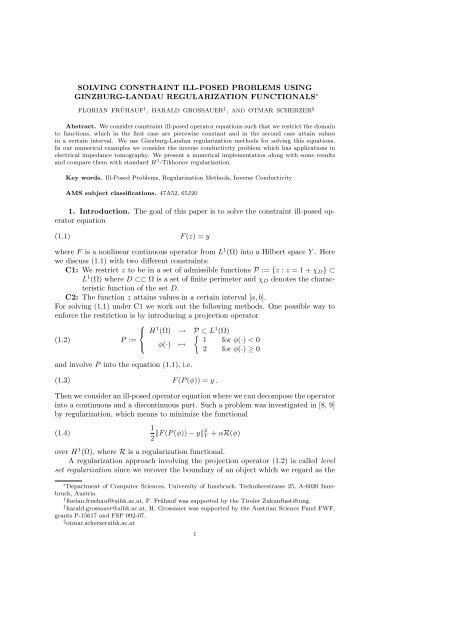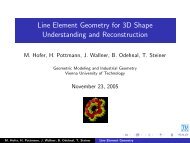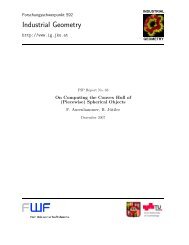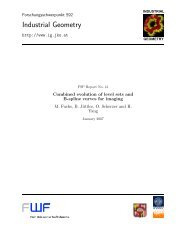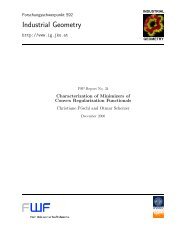Solving constrained ill-posed problems using Ginzburg-Landau ...
Solving constrained ill-posed problems using Ginzburg-Landau ...
Solving constrained ill-posed problems using Ginzburg-Landau ...
Create successful ePaper yourself
Turn your PDF publications into a flip-book with our unique Google optimized e-Paper software.
SOLVING CONSTRAINT ILL-POSED PROBLEMS USING<br />
GINZBURG-LANDAU REGULARIZATION FUNCTIONALS ∗<br />
FLORIAN FRÜHAUF† , HARALD GROSSAUER ‡ , AND OTMAR SCHERZER §<br />
Abstract. We consider constraint <strong>ill</strong>-<strong>posed</strong> operator equations such that we restrict the domain<br />
to functions, which in the first case are piecewise constant and in the second case attain values<br />
in a certain interval. We use <strong>Ginzburg</strong>-<strong>Landau</strong> regularization methods for solving this equations.<br />
In our numerical examples we consider the inverse conductivity problem which has applications in<br />
electrical impedance tomography. We present a numerical implementation along with some results<br />
and compare them with standard H 1 -Tikhonov regularization.<br />
Key words. Ill-Posed Problems, Regularization Methods, Inverse Conductivity<br />
AMS subject classifications. 47A52, 65J20<br />
1. Introduction. The goal of this paper is to solve the constraint <strong>ill</strong>-<strong>posed</strong> operator<br />
equation<br />
(1.1)<br />
F (z) = y<br />
where F is a nonlinear continuous operator from L 1 (Ω) into a Hilbert space Y . Here<br />
we discuss (1.1) with two different constraints:<br />
C1: We restrict z to be in a set of admissible functions P := {z : z = 1 + χ D } ⊂<br />
L 1 (Ω) where D ⊂⊂ Ω is a set of finite perimeter and χ D denotes the characteristic<br />
function of the set D.<br />
C2: The function z attains values in a certain interval [a, b].<br />
For solving (1.1) under C1 we work out the following methods. One possible way to<br />
enforce the restriction is by introducing a projection operator<br />
(1.2)<br />
⎧<br />
⎨<br />
P :=<br />
⎩<br />
H 1 (Ω) → P ⊂ L 1 (Ω)<br />
φ(·)<br />
↦→<br />
and involve P into the equation (1.1), i.e.<br />
{<br />
1 for φ(·) < 0<br />
2 for φ(·) ≥ 0<br />
(1.3)<br />
F (P (φ)) = y .<br />
Then we consider an <strong>ill</strong>-<strong>posed</strong> operator equation where we can decompose the operator<br />
into a continuous and a discontinuous part. Such a problem was investigated in [8, 9]<br />
by regularization, which means to minimize the functional<br />
(1.4)<br />
1<br />
2 ‖F (P (φ)) − y‖2 Y + αR(φ)<br />
over H 1 (Ω), where R is a regularization functional.<br />
A regularization approach involving the projection operator (1.2) is called level<br />
set regularization since we recover the boundary of an object which we regard as the<br />
∗ Department of Computer Sciences, University of Innsbruck, Technikerstrasse 25, A-6020 Innsbruck,<br />
Austria<br />
† florian.fruehauf@uibk.ac.at, F. Frühauf was supported by the Tiroler Zukunftsstiftung.<br />
‡ harald.grossauer@uibk.ac.at, H. Grossauer was supported by the Austrian Science Fund FWF,<br />
grants P-15617 and FSP 092-07.<br />
§ otmar.scherzeruibk.ac.at<br />
1
2 F. FRÜHAUF, H. GROSSAUER AND O. SCHERZER<br />
zero level set of the function φ. Considering characteristic functions as level sets of<br />
higher dimensional data has been used before in the context of multiphase flow (see<br />
e.g. [16, 22, 6]) and segmentation (see e.g. [5]). Level set methods have been used<br />
successfully in many applications since the pioneering work of Osher and Sethian [19].<br />
For solving inverse <strong>problems</strong> with level sets we refer to [20, 4, 8].<br />
Another possibility to constrain z to be in P is by introducing an appropriate<br />
penalizer. To solve (1.1) under constraint C1 we minimize the functional<br />
(1.5)<br />
1<br />
2 ‖F (z) − y‖2 Y + αS ɛ (z) .<br />
We denote minimizers of (1.5) by z ɛ,α . The functional S ɛ is taken in such a way, that<br />
for ɛ → 0 we have z ɛ,α (x) ∈ {1, 2}. We choose a real <strong>Ginzburg</strong>-<strong>Landau</strong> (GL) type<br />
functional as regularizer S ɛ in (1.5), which means<br />
∫ ( ɛ<br />
S ɛ (z) :=<br />
2 |∇z|2 + 1 )<br />
(1.6)<br />
ɛ W (z) dx<br />
Ω<br />
where W is an appropriate potential. Such GL functionals were also used in topological<br />
optimization, see [14] or for modelling immiscible fluids, cf. [1, p.99].<br />
Next we consider constraint C2. A standard approach for solving nonlinear <strong>problems</strong><br />
is regularization. Therefore we minimize<br />
(1.7)<br />
1<br />
2 ‖F (z) − y‖2 Y + αR(z) .<br />
<strong>Solving</strong> such nonlinear <strong>problems</strong> is discussed in [17, 18, 7], where classical results on<br />
convergence and stability are described.<br />
To make use of the a-priori knowledge that z has values in [a, b] we take a complex<br />
GL regularizer. We achieve this by <strong>using</strong> a complex valued function v with real part<br />
z = R(v) and minimize<br />
1<br />
(1.8)<br />
2 ‖F (z) − y‖2 Y + αT (v) .<br />
We choose as regularizer a complex GL functional<br />
∫ ( λ<br />
T (v) :=<br />
2 |∇v|2 + 1 )<br />
(1.9)<br />
λ W (v) dx ,<br />
Ω<br />
where W is taken in an appropriate way to enforce z ∈ [a, b].<br />
So far such functionals were applied in digital inpainting to reconstruct missing<br />
areas in pictures, cf. [10]. Equations like (1.9) have proven to be useful in several<br />
areas, for example to describe phase transitions in superconductors near critical temperatures,<br />
cf. [13], or to model some types of chemical reactions like the famous<br />
Belousov-Zhabotinsky reaction, to specify boundary layers in multi-phase systems,<br />
and to describe the development of patterns and shocks in non-equilibrium systems,<br />
cf. [11, 15, 21]. To the best of our knowledge complex regularization functionals have<br />
not been used for solving <strong>ill</strong>-<strong>posed</strong> operator equations with constraint C2.<br />
Note that in C1 we are only interested in reconstructing the shape of D whereas<br />
in C2 we have the possibility to determine concrete values of z.<br />
The outline of this paper is as follows. In section 2 we describe the regularization<br />
methods considered in this paper. The existence of minimizers is guaranteed. Furthermore<br />
the optimality conditions and the numerical implementation for an inverse<br />
conductivity problem is described in section 3. Finally, in section 4 we present some<br />
results and discuss them.
GINZBURG-LANDAU REGULARIZATION 3<br />
2. The regularization functionals. In this section we analyze properties of the<br />
regularization functionals. Let Ω ⊂ IR 2 be an open bounded domain with sufficiently<br />
smooth boundary. First we consider (1.1) under constraint C1:<br />
1. Tikhonov: To minimize (1.4) we follow [8], where detailed analysis to this<br />
method can be found, when R consists of a bounded variation seminorm<br />
term and the H 1 -Tikhonov regularization functional. Here we just consider<br />
the H 1 -Tikhonov regularization functional, i.e., R(φ) = 1 2 ‖φ−φ 0‖ 2 H 1 (Ω) . The<br />
function φ 0 is an a-priori guess. We approximate the discontinuous projection<br />
P by a Lipschitz continuous operator<br />
(2.1)<br />
⎧<br />
⎨<br />
P ɛ (φ)(x) :=<br />
⎩<br />
Then we minimize the functional<br />
1 for φ(x) < −ɛ<br />
2 + φ(x)<br />
ɛ<br />
for − ɛ ≤ φ(x) ≤ 0<br />
2 for φ(x) > 0<br />
, x ∈ Ω .<br />
(2.2)<br />
F ɛ,α (φ) := 1 2 ‖F (P ɛ(φ)) − y‖ 2 Y + αR(φ)<br />
over H 1 (Ω) and denote the minimizer by φ ɛ,α . Thereafter we understand the<br />
minimizer φ α of (1.4) as<br />
φ α = lim<br />
ɛ→0+ φ ɛ,α<br />
where the limit is understood in an appropriate sense.<br />
For the computation of a minimum of the functional (2.2) we need the<br />
variational derivative of R(φ) = 1 2 ‖φ − φ 0‖ 2 H 1 (Ω) . It is well known to be<br />
R ′ (φ) = (I − ∆)(φ − φ 0 ).<br />
2. Real GL: Now we observe the functional S ɛ from (1.6) with the potential<br />
W . Here W denotes a symmetric double well potential, i.e., a potential with<br />
two minima. The location of the minima is chosen at the desired values of<br />
z ɛ,α . For our problem an obvious choice would be<br />
(2.3)<br />
W (s) = 1 4 ((s − 2) · (s − 1))2 .<br />
For fixed α > 0, according to a result of Modica & Mortola (see [1, sections<br />
14 and 15]), lim<br />
ɛ→0<br />
S ɛ (z) < ∞ if and only if z = 1 + χ D .<br />
An easy calculation shows<br />
(2.4)<br />
S ′ ɛ(z) = −ɛ∆z + 1 ɛ (z − 1)(z − 2)(z − 3 2 ) .<br />
Let us denote by z ɛ (·, t) the gradient flow of S ɛ , i.e., the solution of the semilinear<br />
parabolic equation<br />
(2.5)<br />
∂z<br />
∂t = ɛ∆z − 1 ɛ (z − 1) (z − 2)(z − 3 2 )<br />
which is a real GL equation. For a bounded, open set E ⊂⊂ Ω with smooth<br />
boundary we have that for ɛ → 0<br />
(2.6)<br />
z ɛ (x, t) → 2, for (x, t) ∈<br />
⋃<br />
E t × {t}<br />
(2.7)<br />
z ɛ (x, t) → 1, for (x, t) ∈<br />
t∈[0,T )<br />
⋃<br />
t∈[0,T )<br />
(Ω \ E t ) × {t}
4 F. FRÜHAUF, H. GROSSAUER AND O. SCHERZER<br />
for solutions of (2.5) with z ɛ (·, 0) = 1 + χ σ E . Here χσ E denotes a slightly<br />
smoothed version of χ E with sgn(χ σ E ) = sgn(χ E), and E t denotes the set<br />
which originates from E if its boundary ∂E evolves under mean curvature<br />
motion up to time T . In this sense (2.5) approximates mean curvature motion<br />
as ɛ tends to zero. Further details can be found in [1].<br />
To solve (1.1) under constraint C2 we observe the following methods:<br />
1. Tikhonov: To minimize the functional (1.7) we choose again the H 1 -Tikhonov<br />
regularization functional R(z) = 1 2 ‖z − z 0‖ 2 H 1 (Ω). Here we do not introduce<br />
the constraint z ∈ [a, b].<br />
2. Complex GL: Finally we consider the complex GL functional T from (1.9).<br />
In the example in 4.2 we have the a-priori knowledge that z(x) ∈ [1, 2] for<br />
x ∈ Ω. Therefore we set<br />
(2.8)<br />
W (s) = 1 4<br />
(<br />
|s − 3 2 |2 − 1 ) 2<br />
4<br />
which attains its minimum on the complex sphere with center 3 2<br />
1<br />
2<br />
. Thus we force z to have values in [1, 2].<br />
We find the variational derivative of T<br />
T ′ (v) = −λ∆v + 1 (<br />
|v − 3 λ 2 |2 − 1 ) (<br />
v − 3 )<br />
(2.9)<br />
.<br />
4 2<br />
and radius<br />
(<br />
Solutions of −λ∆v + 1 λ |v| 2 − 1 ) v = 0 have been investigated in detail in<br />
[2]. Equation (2.9) is attained by an appropriate coordinate transform and<br />
therefore its solutions have similar properties.<br />
We can guarantee the existence of a minimizer for F ɛ,α .<br />
Theorem 2.1. The functional F ɛ,α from (2.2) attains a minimizer φ ɛ,α , if R<br />
is weak lower semi continuous, if there exist c > 0 and b ∈ IR such that R(φ) ><br />
c‖φ‖ 2 H 1 (Ω) + b for all φ ∈ H1 (Ω), and there exists at least one ˜φ ∈ H 1 (Ω) such that<br />
F ɛ,α ( ˜φ) is finite.<br />
The proof for the Tikhonov regularization can be found in [8]. To fulf<strong>ill</strong> the<br />
required conditions of the regularization functional we need appropriate boundary<br />
conditions for the GL regularizers, for example see section 3.2. Then the theorem is<br />
also applicable for the functionals (1.5), (1.7) and (1.8).<br />
Note that the assumptions of the theorem do not necessarily imply that lim P (φ ɛ,α) ∈<br />
ɛ→0+<br />
P. In [8] this condition was enforced by introducing the BV-seminorm |P ɛ (φ)| BV as<br />
additional penalizing term.<br />
3. Numerics. To receive a minimizer of the functionals we calculate the formal<br />
optimality conditions. In section 2 we derived the variational derivatives of the<br />
regularizing terms. Now we consider the derivative of the data term.<br />
3.1. The variational derivative of the data term. In our numerical examples<br />
we consider an operator F which corresponds to the inverse conductivity problem.<br />
We can formulate the <strong>problems</strong> as follows:<br />
C1: We are interested in determining inclusions of constant conductivity in a<br />
surrounding medium of a different constant conductivity.<br />
C2: We want to reconstruct conductivities which are assumed to take on values<br />
in a certain interval.
Therefore we consider the Neumann problem<br />
(3.1)<br />
GINZBURG-LANDAU REGULARIZATION 5<br />
∇ · (a∇u) = 0 in Ω ,<br />
∫ a ∂u<br />
∂ν<br />
= h on ∂Ω ,<br />
∂Ω u ds = 0 .<br />
It is well known that there exists a unique solution u ∈ H 1 (Ω) if h ∈ L 2 ⋄(∂Ω) :=<br />
{<br />
u ∈ L 2 (∂Ω) : ∫ ∂Ω u ds = 0} and a ∈ L ∞ + (Ω). In C1 we restrict us to conductivities<br />
(3.2)<br />
a =<br />
{ 2 in D<br />
1 in Ω \ D .<br />
In C2 the conductivity a is piecewise C 2 (Ω, [1, 2]). These restrictions on the conductivity<br />
guarantee that a ∈ L 1 (Ω) ∩ L 2 (Ω). Let g = u| ∂Ω ∈ L 2 ⋄(∂Ω) be the trace of u<br />
and h ≢ 0 fixed. We introduce the operator<br />
{<br />
L<br />
F h :<br />
1 (Ω) → L<br />
(3.3)<br />
2 ⋄(∂Ω)<br />
.<br />
a ↦→ g<br />
The inverse problem consist in reconstructing the unknown conductivity a from<br />
the knowledge of the Neumann data h and the corresponding Dirichlet data g. Then<br />
the following proposition applies, cf. [12, Theorem 5.7.1].<br />
Proposition 3.1. Let D 1 , D 2 be open subdomains of Ω with Lipschitz boundaries<br />
such that Ω \ D i , i = 1, 2 are connected and D i ⊂⊂ Ω. Assume γ is a given C 2 (Ω)-<br />
function and<br />
a i := γ + χ Di k i<br />
where k i is C 2 (Ω)-function with k i ≠ 0 on ∂D i , i = 1, 2. Then<br />
F h (a 1 ) = F h (a 2 ) implies a 1 = a 2 .<br />
The same result is applicable if a i ∈ W 1,p (Ω) for p > 1, cf. [3].<br />
Let us now take Y = L 2 ⋄(∂Ω), then we receive the variational derivatives<br />
(3.4)<br />
and<br />
(3.5)<br />
1 δ<br />
2 δz ‖F (z) − y‖2 Y := F ′ (z) ∗ (F (z) − y)<br />
1 δ<br />
2 δφ ‖F (P ɛ(φ)) − y‖ 2 Y := P ɛ(φ)F ′ ′ (P ɛ (φ)) ∗ (F (P ɛ (φ)) − y)<br />
where the adjoint is taken with respect to the L 2 (Ω) scalar product. Following [9] the<br />
adjoint operator F ′ h (a)∗ of the Frechet-derivative of F h has the following form<br />
F ′ h(a) ∗ (s) = −∇u · ∇w s ,<br />
for each s ∈ L 2 ⋄(∂Ω),<br />
where u is a solution of (3.1) and w s solves (3.1) with Neumann boundary condition<br />
a ∂w s<br />
∂ν<br />
= s. Therefore we receive the following algorithm to calculate F h ′ (P ɛ(φ)) ∗ (F h (P ɛ (φ))−<br />
y):<br />
1. Calculate F h (P ɛ (φ)): Solve the Neumann problem<br />
(3.6)<br />
Then F h (P ɛ (φ)) = u| ∂Ω .<br />
∇ · (P ɛ (φ)∇u) = 0 in Ω ,<br />
P∫<br />
ɛ (φ) ∂u<br />
∂ν<br />
= h on ∂Ω ,<br />
∂Ω u ds = 0 .
6 F. FRÜHAUF, H. GROSSAUER AND O. SCHERZER<br />
2. Evaluate the residual r = F h (P ɛ (φ)) − y.<br />
3. Calculate F ′ h (P ɛ(φ)) ∗ (r): Solve the Neumann problem<br />
∇ · (P ɛ (φ)∇w) = 0 in Ω ,<br />
P∫<br />
ɛ (φ) ∂w<br />
∂ν<br />
= r on ∂Ω ,<br />
∂Ω w ds = 0 .<br />
Then F ′ h (P ɛ(φ)) ∗ (r) = −∇u · ∇w.<br />
Note that the same minimization algorithm applies to F ′ h (z)∗ (F h (z) − y) if we replace<br />
P ɛ (φ) by z.<br />
3.2. Implementation. The approach for solving C1 and C2 is essentially the<br />
same and therefore we do not distinguish between the two cases unless it is special<br />
mentioned.<br />
1. Tikhonov: We use the same implementation as in [8].<br />
2. GL: To minimize the functionals (1.5), resp., (1.8) we employ a gradient<br />
descent method, i.e., we solve the “time dependent” PDE<br />
(3.7)<br />
resp.,<br />
∂z<br />
∂t = −F ′ (z) ∗ (F (z) − y) − αS ′ ɛ(z)<br />
∂v<br />
(3.8)<br />
∂t = −F ′ (z) ∗ (F (z) − y) − αT ′ (v)<br />
up to a stationary state in time.<br />
Since all solution methods are iterative we have to prescribe an initial guess φ 0 , z 0<br />
or v 0 . Numerical experiments have shown that the solutions do not depend on the<br />
choice of the initial guess as long as some natural assumptions are fulf<strong>ill</strong>ed, see section<br />
4.<br />
For our numerics we want to reconstruct conductivities of the form given in proposition<br />
3.1 with γ ≡ 1. The inclusion D is not necessarily connected. For C1 we set<br />
k = 1 and use the following boundary conditions. For the Tikhonov regularization<br />
method we adopt Neumann boundary conditions, cf. [8]. The boundary value<br />
z| ∂Ω = 1 for the real GL regularizer was chosen to be a stationary value of the potential<br />
W . For C2 we get better results if we introduce the Dirichlet boundary condition<br />
z| ∂Ω = 1 to the Tikhonov regularization method, since D should be completely contained<br />
in Ω. For the complex GL regularization we use the Dirichlet boundary data<br />
equal to v = 1 since this is a minimum of the corresponding potential.<br />
We use a finite difference discretization, and perform explicit Euler time stepping<br />
for all methods except the Tikhonov regularization. The two elliptic PDEs related<br />
to the operator F (see section 3.1) are solved directly by <strong>using</strong> Matlab’s backslash<br />
operator.<br />
For our numerical examples we used Ω = (0, 1) 2 discretized with a homogeneous<br />
rectangular grid with gridsize ∆x. For all regularizations in C1 the parameter ɛ<br />
corresponds roughly to the width of the inclusion boundary in the solution. Thus we<br />
set ɛ = ∆x to achieve maximally sharp object boundaries within the limits im<strong>posed</strong><br />
by the discretization.<br />
The Neumann boundary data h to calculate the operator F h (see (3.6)) were<br />
chosen as two periods of the sine function extending around the unit square.<br />
The boundary measurement data y for solving the inverse problem are obtained by<br />
solving the elliptic boundary value problem (3.1). In order to avoid “inverse crimes”<br />
the direct problem (3.1) is solved on a finer grid than the inverse problem.
GINZBURG-LANDAU REGULARIZATION 7<br />
0<br />
2<br />
0<br />
2<br />
0<br />
2<br />
0.1<br />
1.9<br />
0.1<br />
1.9<br />
0.1<br />
1.9<br />
0.2<br />
1.8<br />
0.2<br />
1.8<br />
0.2<br />
1.8<br />
0.3<br />
1.7<br />
0.3<br />
1.7<br />
0.3<br />
1.7<br />
0.4<br />
1.6<br />
0.4<br />
1.6<br />
0.4<br />
1.6<br />
0.5<br />
1.5<br />
0.5<br />
1.5<br />
0.5<br />
1.5<br />
0.6<br />
1.4<br />
0.6<br />
1.4<br />
0.6<br />
1.4<br />
0.7<br />
1.3<br />
0.7<br />
1.3<br />
0.7<br />
1.3<br />
0.8<br />
1.2<br />
0.8<br />
1.2<br />
0.8<br />
1.2<br />
0.9<br />
1.1<br />
0.9<br />
1.1<br />
0.9<br />
1.1<br />
1 1<br />
0 0.2 0.4 0.6 0.8 1<br />
1 1<br />
0 0.2 0.4 0.6 0.8 1<br />
1 1<br />
0 0.2 0.4 0.6 0.8 1<br />
two squares constant “8” ramp “8”<br />
Fig. 4.1. The three conductivities which should be reconstructed.<br />
4. Results and Discussion.<br />
4.1. Examples for C1. In our experiments we take random initial data for real<br />
GL regularization, such that 1 ≤ z 0 (x) ≤ 2 for all x ∈ Ω. For this choice the initial<br />
values lie between the two minima of the potential W . We used a signed distance<br />
function centered in Ω as initial condition such that P ɛ (φ 0 )| ∂Ω = 1 and that P ɛ(φ ′ 0 ) > 0<br />
for some x ∈ Ω for the Tikhonov regularization.<br />
The conductivities which we want to reconstruct are plotted in figure 4.1 left,<br />
resp., middle. In figure 4.2, resp., 4.3 we show results obtained by <strong>using</strong> different regularizers<br />
for reconstructing. For the real GL regularizer we directly plot the solution<br />
z, whereas for the Tikhonov we plot the projection P ɛ (φ). Note that the resolution<br />
in figure 4.1 is finer than in the other figures.<br />
In the first experiment we want to reconstruct two squares located at opposite<br />
corners of Ω. For both regularizers a spurious signal remains in the center of Ω for<br />
many iterations. The reason for this phenomenon is that the influence of the boundary<br />
values spreads slowly into the interior. After the spurious signal has vanished higher<br />
values remain only in the locations of the squares. The shape of the two squares is better<br />
recognized with the real GL regularization, therefor with the Tikhonov regularizer<br />
the boundaries are sharper.<br />
In the second experiment a nonconvex inclusion should be reconstructed. We<br />
derive nearly the same effects for both regularizers as in the previous example. Again<br />
good reconstructions are achieved by the Tikhonov and the real GL regularization<br />
but the concavity on the right side is lost by the Tikhonov regularization.<br />
4.2. Examples for C2. For C2 we take initial data as follows:<br />
1. Tikhonov: z 0 (x) = 1 for all x ∈ Ω<br />
2. complex GL: R(v 0 (x)) = 1 and I(v 0 (x)) = 0 for all x ∈ Ω<br />
In the experiment we want to reconstruct the same “8”-shaped inclusion as for C1, but<br />
now we have a slope in the conductivity, cf. the right picture in figure 4.1. Note that<br />
this conductivity is not in H 1 (Ω) but the minimizers of the functionals necessarily are<br />
in H 1 (Ω).<br />
The results are plotted in figure 4.4. The Tikhonov regularization reconstructs<br />
the maximum values better, but there is a distinctive minimum of the values in the<br />
middle of the “8”. The slope of the conductivity is reconstructed by the complex GL<br />
method. Furthermore the reconstruction of the surrounding medium is better by the<br />
complex GL regularization.<br />
Now we consider the same example, where we add 3 % gaussian noise to the<br />
data. The reconstructions are shown in figure 4.5. Again the maximum values in the<br />
object are found better by the Tikhonov regularizer. But the slope is not recognized
8 F. FRÜHAUF, H. GROSSAUER AND O. SCHERZER<br />
Tikhonov, α = 0.06<br />
0<br />
2<br />
0<br />
2<br />
0<br />
2<br />
0.1<br />
1.9<br />
0.1<br />
1.9<br />
0.1<br />
1.9<br />
0.2<br />
1.8<br />
0.2<br />
1.8<br />
0.2<br />
1.8<br />
0.3<br />
1.7<br />
0.3<br />
1.7<br />
0.3<br />
1.7<br />
0.4<br />
1.6<br />
0.4<br />
1.6<br />
0.4<br />
1.6<br />
0.5<br />
1.5<br />
0.5<br />
1.5<br />
0.5<br />
1.5<br />
0.6<br />
1.4<br />
0.6<br />
1.4<br />
0.6<br />
1.4<br />
0.7<br />
1.3<br />
0.7<br />
1.3<br />
0.7<br />
1.3<br />
0.8<br />
1.2<br />
0.8<br />
1.2<br />
0.8<br />
1.2<br />
0.9<br />
1.1<br />
0.9<br />
1.1<br />
0.9<br />
1.1<br />
1<br />
0 0.2 0.4 0.6 0.8 1<br />
1<br />
1<br />
0 0.2 0.4 0.6 0.8 1<br />
1<br />
1<br />
0 0.2 0.4 0.6 0.8 1<br />
1<br />
after 50 iterations after 400 iterations after 2000 iterations<br />
Real <strong>Ginzburg</strong>-<strong>Landau</strong>, α = 10 −6<br />
0<br />
2<br />
0<br />
2<br />
0<br />
2<br />
0.1<br />
1.9<br />
0.1<br />
1.9<br />
0.1<br />
1.9<br />
0.2<br />
1.8<br />
0.2<br />
1.8<br />
0.2<br />
1.8<br />
0.3<br />
1.7<br />
0.3<br />
1.7<br />
0.3<br />
1.7<br />
0.4<br />
1.6<br />
0.4<br />
1.6<br />
0.4<br />
1.6<br />
0.5<br />
1.5<br />
0.5<br />
1.5<br />
0.5<br />
1.5<br />
0.6<br />
1.4<br />
0.6<br />
1.4<br />
0.6<br />
1.4<br />
0.7<br />
1.3<br />
0.7<br />
1.3<br />
0.7<br />
1.3<br />
0.8<br />
1.2<br />
0.8<br />
1.2<br />
0.8<br />
1.2<br />
0.9<br />
1.1<br />
0.9<br />
1.1<br />
0.9<br />
1.1<br />
1<br />
0 0.2 0.4 0.6 0.8 1<br />
1<br />
1<br />
0 0.2 0.4 0.6 0.8 1<br />
1<br />
1<br />
0 0.2 0.4 0.6 0.8 1<br />
1<br />
after 100 iterations after 1000 iterations after 3400 iterations<br />
Fig. 4.2. Course of evolution for the regularizers of C1<br />
Tikhonov<br />
Real <strong>Ginzburg</strong>-<strong>Landau</strong><br />
0<br />
2<br />
0<br />
2<br />
0.1<br />
1.9<br />
0.1<br />
1.9<br />
0.2<br />
1.8<br />
0.2<br />
1.8<br />
0.3<br />
1.7<br />
0.3<br />
1.7<br />
0.4<br />
1.6<br />
0.4<br />
1.6<br />
0.5<br />
1.5<br />
0.5<br />
1.5<br />
0.6<br />
1.4<br />
0.6<br />
1.4<br />
0.7<br />
1.3<br />
0.7<br />
1.3<br />
0.8<br />
1.2<br />
0.8<br />
1.2<br />
0.9<br />
1.1<br />
0.9<br />
1.1<br />
1<br />
0 0.2 0.4 0.6 0.8 1<br />
1<br />
1<br />
0 0.2 0.4 0.6 0.8 1<br />
1<br />
α = 0.05, 4500 iterations<br />
α = 1 · 10 −6 , 1500 iterations<br />
Fig. 4.3. Stationary solutions of the regularizes of C1.<br />
satisfactory as well as the surrounding medium. The reconstruction with the complex<br />
GL regularizer of the surrounding medium is quite good. The constant slope of the<br />
conductivity in the object is found, but the values are not correct.<br />
REFERENCES<br />
[1] L. Ambrosio and N. Dancer. Calculus of Variations and Partial Differential Equations. Springer<br />
Verlag, 2000.<br />
[2] F. Bethuel, H. Brezis, and F. Helein. <strong>Ginzburg</strong>-<strong>Landau</strong> Vortices, volume 13 of Progress in<br />
Nonlinear Differential Equations and Their Applications. Birkhaeuser, 1994.<br />
[3] R.M. Brown and G. Uhlmann. Uniqueness in inverse conductivity problem for nonsmooth<br />
conductivities in two dimensions. Commun. Part. Diff. Equations, 22:1009–1027, 1997.<br />
[4] M. Burger. A level set method for inverse <strong>problems</strong>. Inverse Problems, 17:1327–1355, 2001.<br />
[5] T. Chan, J. Shen, and L. Vese. Variational pde models in image processing. Notices Amer.<br />
Math. Soc., 50:14–26, 2003.<br />
[6] S. Chen, B. Merriman, S. Osher, and P. Smereka. A simple level set method for solving stefan<br />
<strong>problems</strong>. J. Comput. Phys., 135:8–29, 1997.<br />
[7] H.W. Engl, M. Hanke, and A. Neubauer. Regularization of Inverse Problems. Kluwer Academic
GINZBURG-LANDAU REGULARIZATION 9<br />
Tikhonov<br />
Complex <strong>Ginzburg</strong>-<strong>Landau</strong><br />
0<br />
0<br />
0.1<br />
1.7<br />
0.1<br />
1.6<br />
0.2<br />
1.6<br />
0.2<br />
0.3<br />
1.5<br />
0.3<br />
1.5<br />
0.4<br />
1.4<br />
0.4<br />
1.4<br />
0.5<br />
0.6<br />
1.3<br />
0.5<br />
0.6<br />
1.3<br />
0.7<br />
1.2<br />
0.7<br />
1.2<br />
0.8<br />
1.1<br />
0.8<br />
1.1<br />
0.9<br />
1<br />
0 0.2 0.4 0.6 0.8 1<br />
1<br />
0.9<br />
1<br />
0 0.2 0.4 0.6 0.8 1<br />
1<br />
1.7<br />
1.6<br />
1.8<br />
1.6<br />
1.8<br />
1.7<br />
1.7<br />
1.5<br />
1.6<br />
1.5<br />
1.6<br />
1.5<br />
1.4<br />
1.5<br />
1.4<br />
1.4<br />
1.4<br />
1.3<br />
1.3<br />
1.3<br />
1.3<br />
1.2<br />
1.2<br />
1.1<br />
1.2<br />
1.1<br />
1.2<br />
1<br />
0.9<br />
30<br />
20<br />
10<br />
10<br />
20<br />
30<br />
1.1<br />
1<br />
1<br />
0.9<br />
30<br />
20<br />
10<br />
10<br />
20<br />
30<br />
1.1<br />
1<br />
0<br />
α = 0.01, 2500 iterations<br />
0<br />
0<br />
α = 5 · 10 −6 , 1500 iterations<br />
0<br />
Fig. 4.4. Stationary solutions of both regularizes for C2. Note that the results are differently<br />
scaled.<br />
0<br />
Tikhonov<br />
0<br />
Complex <strong>Ginzburg</strong>-<strong>Landau</strong><br />
0.1<br />
2<br />
0.1<br />
1.7<br />
0.2<br />
1.8<br />
0.2<br />
1.6<br />
0.3<br />
1.6<br />
0.3<br />
1.5<br />
0.4<br />
0.4<br />
0.5<br />
1.4<br />
0.5<br />
1.4<br />
0.6<br />
1.2<br />
0.6<br />
1.3<br />
0.7<br />
0.7<br />
1.2<br />
0.8<br />
1<br />
0.8<br />
1.1<br />
0.9<br />
0.8<br />
0.9<br />
1<br />
0 0.1 0.2 0.3 0.4 0.5 0.6 0.7 0.8 0.9 1<br />
1<br />
0 0.1 0.2 0.3 0.4 0.5 0.6 0.7 0.8 0.9 1<br />
1<br />
2<br />
1.7<br />
2.2<br />
2<br />
1.8<br />
1.8<br />
1.7<br />
1.6<br />
1.8<br />
1.6<br />
1.4<br />
1.2<br />
1<br />
0.8<br />
0.6<br />
1<br />
0.8<br />
1<br />
0.6<br />
0.8<br />
0.4<br />
0.6<br />
0.4<br />
0.2<br />
0.2<br />
0 0<br />
α = 0.005, 1500 iterations<br />
1.6<br />
1.4<br />
1.2<br />
1<br />
0.8<br />
1.6<br />
1.5<br />
1.5<br />
1.4<br />
1.4<br />
1.3<br />
1.2<br />
1.3<br />
1.1<br />
1<br />
1.2<br />
0.9<br />
1<br />
0.8<br />
1<br />
1.1<br />
0.6<br />
0.8<br />
0.4<br />
0.6<br />
0.4<br />
0.2<br />
1<br />
0.2<br />
0 0<br />
α = 6.3 · 10 −6 , 2500 iterations<br />
Fig. 4.5. Stationary solutions of both regularizes for C2 with noise. Note that the results are<br />
differently scaled.
10 F. FRÜHAUF, H. GROSSAUER AND O. SCHERZER<br />
Publishers, Dordrecht, 1996.<br />
[8] F. Fruehauf, O. Scherzer, and A. Leitao. Analysis of regularization methods for the solution<br />
of <strong>ill</strong>-<strong>posed</strong> <strong>problems</strong> involving discontinuous operations. SIAM Journal on Numerical<br />
Analysis, accepted for publication 2005.<br />
[9] R. Griesmaier. A level set method for the solution of the inverse conductivity problem and<br />
several distance measures as error criterion for inverse <strong>problems</strong>. Master’s thesis, Leopold<br />
Franzens University Innsbruck, Austria, 2004.<br />
[10] H. Grossauer and O. Scherzer. Using the complex ginzburg-landau equation for digital inpainting<br />
in 2d and 3d. Scale Space Methods in Computer Vision, pages 225–236, 2003.<br />
[11] M. Ipsen and P. Sorensen. Wavelength instabilities in a slow mode coupled complex ginzburglandau<br />
equation. Physical Review Letters, 84(11):2389, 2000.<br />
[12] V. Isakov. Inverse Problems for Partial Differential Equations, volume 127 of Applied Mathematical<br />
Sciences. Springer, 1998.<br />
[13] L. <strong>Landau</strong> and V. <strong>Ginzburg</strong>. On theory of superconductivity. Journal of Experimental and<br />
Theoretical Physics (USSR), 20:1064, 1950.<br />
[14] R. Stainko M. Burger. Phase-field relaxation of topology optimization with local stress constraints.<br />
Submitted to: SIAM Journal On Control and Optimization, submitted 2005.<br />
[15] E. de Wit M. van Hecke and W. van Saarloos. Coherent and incoherent drifting pusle dynamics<br />
in a complex ginzburg-landau equation. Physical Review Letters, 75(21):3830, 1995.<br />
[16] B. Merriman, J. Bence, and S. Osher. Motion of multiple functions: a level set approach. J.<br />
Comput. Phys., 112:334–363, 1994.<br />
[17] V.A. Morozov. Methods for <strong>Solving</strong> Incorrectly Posed Problems. Springer Verlag, New York,<br />
Berlin, Heidelberg, 1984.<br />
[18] V.A. Morozov. Regularization Methods for Ill-Posed Problems. CRC Press, Boca Raton, 1993.<br />
[19] S. Osher and J.A. Sethian. Fronts propagating with curvature-dependent speed: Algorithms<br />
based on Hamilton-Jacobi formulations. J. Comput. Phys., 79:12–49, 1998.<br />
[20] F. Santosa. A level set approach for inverse <strong>problems</strong> involving obstacles. ESAIM Contrôle<br />
Optim. Calc. Var., 1:17–33 (electronic), 1995/96.<br />
[21] G. Huber T. Bohr and E. Ott. The structur of spiral-domain patterns and shocks in the 2d<br />
complex ginzburg-landau equation. Physica D, 106:95–112, 1997.<br />
[22] H.-K. Zhao, T. Chan, B. Merriman, and S. Osher. A variational level set approach to multiphase<br />
motion. J. Comput. Phys., 127:179–195, 1996.


